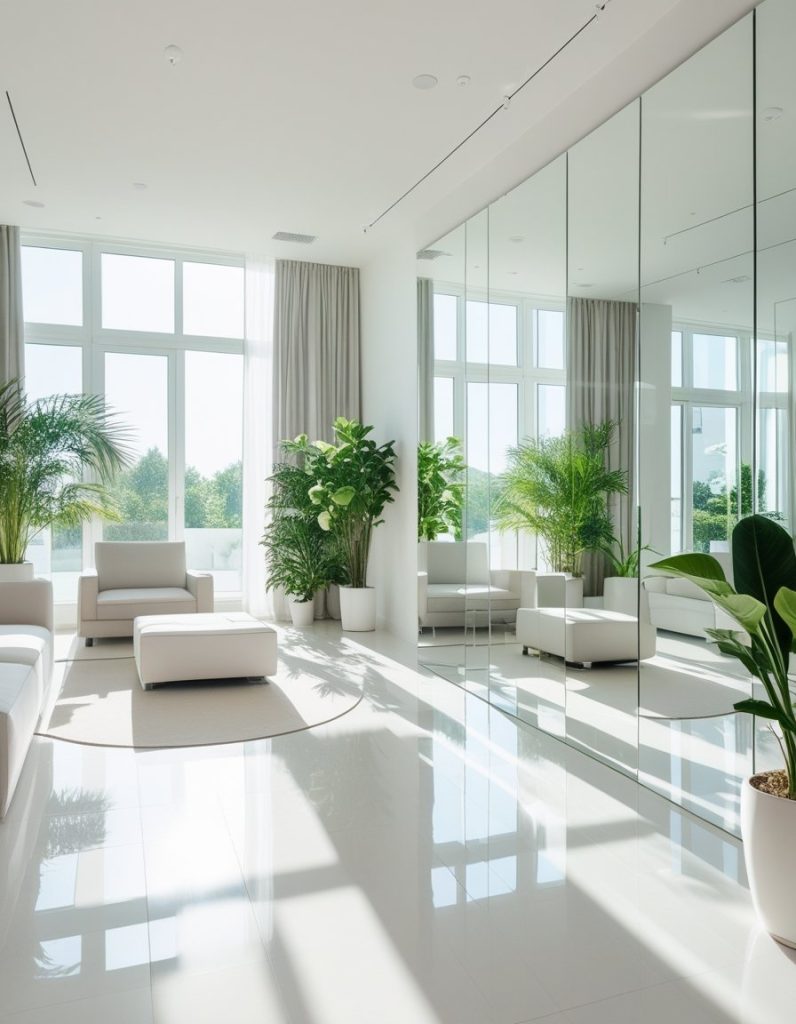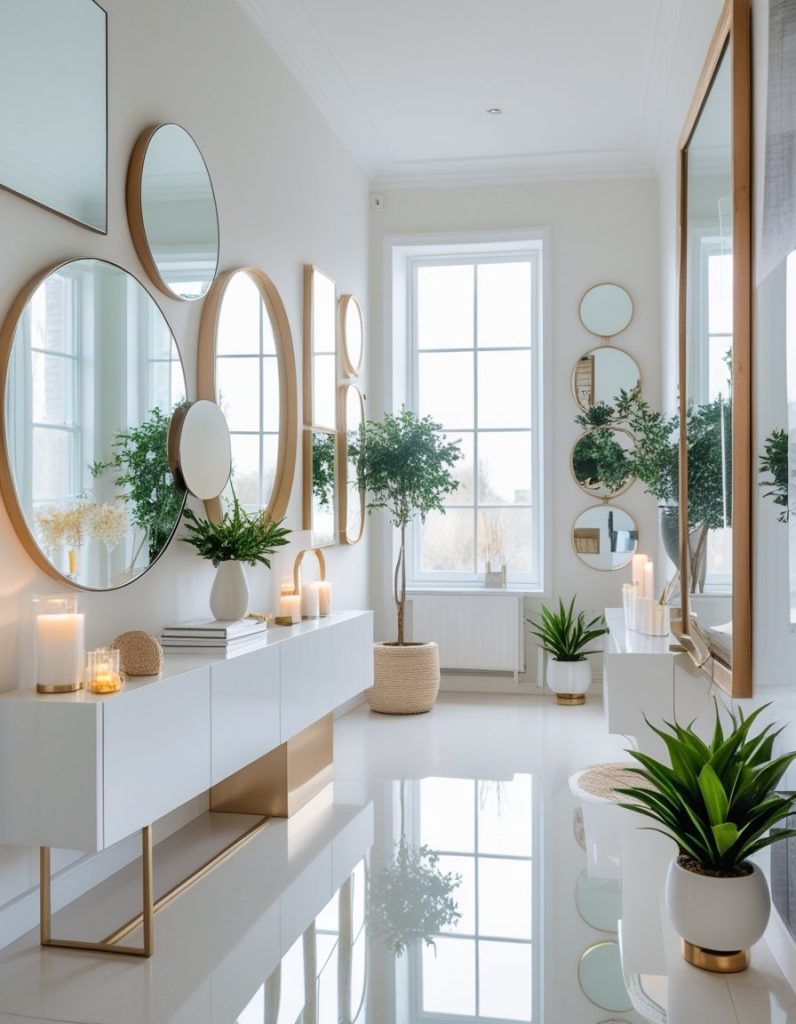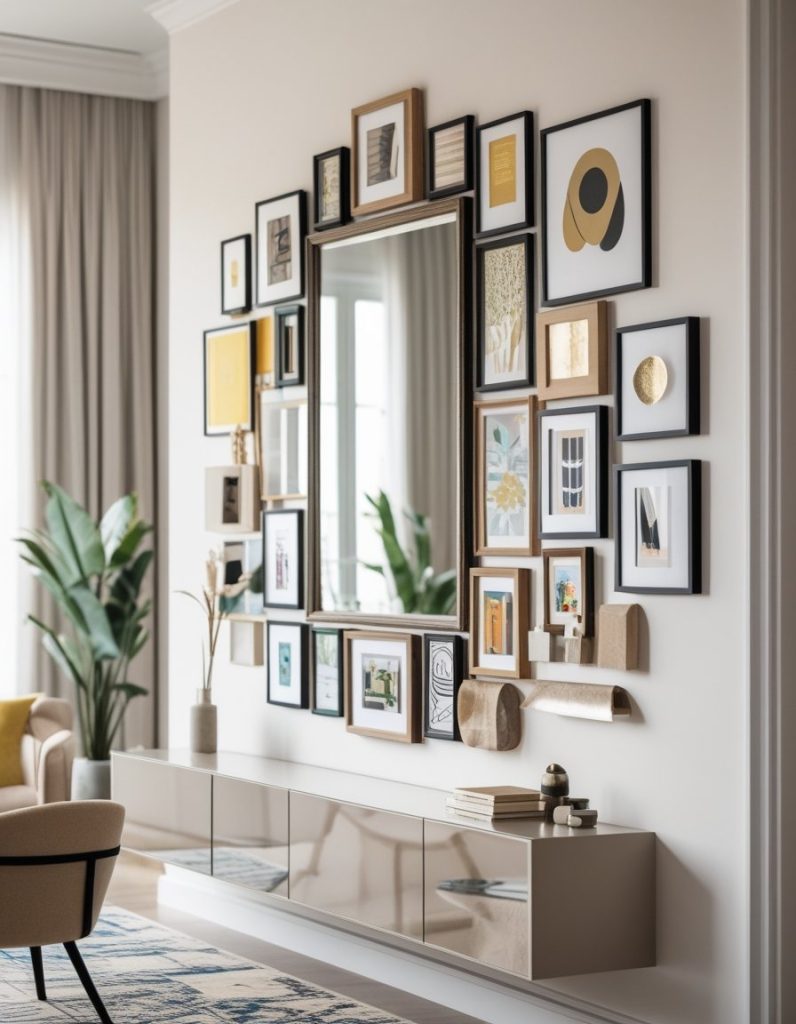Mirror Room Decoration Ideas to Enhance Space and Light that are a versatile tool in room decorating that can enhance both style and functionality. They reflect light to make spaces feel brighter and more open, while also serving as focal points that add character to any room. Strategic mirror placement can visually expand small areas and highlight a room’s best features without overwhelming the space.

Choosing the right shape, size, and frame for a mirror allows it to complement different interior styles, from modern minimalism to vintage charm. Whether used individually or in creative groupings, mirrors offer a simple way to refresh a room’s ambiance and add a personal touch.
Essentials of Mirror Room Decoration

Mirrors can enhance a room’s light, space, and style when chosen and placed thoughtfully. Effective mirror decor balances function with design, helping to elevate overall interior aesthetics while addressing specific spatial challenges.
Benefits of Decorating With Mirrors
Decorating with mirrors adds depth and brightness to spaces by reflecting natural and artificial light. This reflection can make small or dim rooms appear larger and more open.
Mirrors also serve as focal points or accents, contributing elegance or modern flair depending on their style. They are versatile; suitable for living rooms, bedrooms, dining areas, and even narrow hallways.
Additionally, mirrors can emphasize architectural features or art by strategically reflecting them. They blend functionality with decoration, improving both the room’s utility and visual appeal.
Principles of Mirror Placement
Proper placement maximizes a mirror’s impact. Placing mirrors opposite windows is one of the most effective strategies, as it amplifies incoming light and views.
Height and angle are important; mounting mirrors at eye level generally achieves the best balance between practical use and aesthetic effect.
Clustered or gallery-style arrangements add artistic interest, while large, single mirrors create focal points and a sense of spaciousness. Corners and narrow spaces benefit from mirrors positioned to expand visual boundaries.
Avoid placing mirrors where they reflect clutter or unappealing views, as this undermines their decorative purpose.
Choosing the Right Mirror Style
Selecting the correct mirror style depends on room design and intended effect. Ornate, vintage frames introduce charm and sophistication, often suited for traditional interiors.
Minimalist, frameless, or geometric mirrors complement modern or contemporary spaces by adding sleekness and simplicity.
Oversized mirrors can act as statement pieces, while smaller, decorative mirrors work as accents or in groupings.
Consider frame material and color to match or contrast room elements, ensuring the mirror enhances rather than conflicts with existing decor.
Popular Mirror Styles for Room Decor

Mirrors come in a variety of shapes and designs that influence both function and style. Choosing the right mirror can enhance light, add visual interest, and complement existing decor. Key styles vary from bold statement pieces to subtle, classic designs.
Sunburst and Statement Mirrors
Sunburst mirrors feature a central mirror surrounded by radiating spokes, often made of metal or wood. Their design mimics the sun, making them an eye-catching focal point in any room. These mirrors work well above mantels, consoles, or as standalone wall art.
They add a mid-century modern or vintage feel, depending on materials and finishes. A sunburst mirror can brighten a space by reflecting light across the room while providing decorative appeal. Statement mirrors like this often blend form and function effectively.
Arched Mirrors for a Classic Look
Arched mirrors introduce elegance through their curved tops, softening room lines. Their shape suits both traditional and contemporary interiors, often evoking architectural elements like doorways or windows.
Arched mirrors can range from minimal frames to ornate, detailed edges, offering versatility. They work well in bedrooms, bathrooms, or entryways, providing a timeless, classic aesthetic that enhances vertical space. This style often feels inviting and spacious.
Round and Circular Mirror Options
Round and circular mirrors emphasize smooth, continuous shapes that contrast angular furniture and architectural features. They are popular in modern and minimalist settings due to their simplicity and balance.
These mirrors vary in size and can come with thin, thick, or decorative frames. The circular shape creates focal points that draw the eye without overwhelming other decor. Round mirrors also help improve spatial flow by softening the visual environment.
Framed vs. Frameless Mirrors
Framed mirrors offer structure and style through materials like wood, metal, or resin. The frame adds texture and personality to the decor, from ornate antique looks to sleek modern lines.
Frameless mirrors provide a minimalist, clean look that maximizes reflected light and space. Without borders, they blend seamlessly into walls, enhancing room brightness and openness. Choice between framed and frameless depends on desired contrast, room design, and function.
Maximizing Space and Light With Mirrors

Mirrors can greatly improve the perception of both space and light in a room. They reflect and distribute natural light, create a sense of depth, and enhance room openness through carefully planned placement. Using different types of mirrors, such as full-length or decorative mirrors, contributes to both function and style in interior design.
Enhancing Natural Light
Placing mirrors directly across from windows or French doors allows natural light to bounce deeper into the room. This approach illuminates darker corners without relying on additional light sources. Larger mirrors are especially effective, as they capture more sunlight and spread it throughout the space.
Mirrors near sun-filled hallways or beside windows help brighten rooms that may face less favorable directions, like north-facing spaces. Choosing mirrors with minimal framing maximizes reflective surface area, improving light distribution.
Creating the Illusion of Space
Mirrors visually expand a room by reflecting its boundaries and creating depth. A full-length mirror placed on a bedroom wall or closet door can double the perception of height and width. Decorative mirrors with interesting shapes or bold frames add dimension without overwhelming the space.
Using oversized mirrors in small rooms makes them feel larger and less confined. This effect works best when the mirror complements the room’s proportions and décor, preventing the space from feeling cluttered or disorienting.
Strategic Mirror Placement
Mirror placement is crucial for optimizing both light and spatial effects. Placing a mirror at eye level above a dresser can reflect window light while avoiding reflecting the bed, which may disrupt the room’s balance.
Floor-to-ceiling mirrors installed on closet doors serve dual functions: they enhance light reflection and create depth. It’s important to avoid placing mirrors where tension or glare may occur, such as opposite bright artificial lights or too close to direct sunlight, to maintain comfort and visual harmony.
Mirror Room Decoration Ideas by Room

Mirrors can serve both functional and decorative purposes depending on their placement and style. Using the right mirror shapes and sizes enhances lighting, depth, and spatial perception in different rooms.
Living Room Mirror Ideas
In living rooms, large wall mirrors create a focal point and make the space appear larger. Positioning a full-length mirror opposite a window reflects natural light, brightening the entire room. Mirrors with decorative frames add character without overwhelming the design.
Gallery wall arrangements with multiple small and medium mirrors offer visual interest and can complement furniture styles. Oversized mirrors mounted above a sofa or mantelpiece add sophistication while increasing light. Round or geometric shapes work well to break up the rigidity of rectangular furniture.
Bedroom Mirror Arrangements
Bedrooms benefit from mirrors that serve both practical and aesthetic purposes. A full-length mirror near the closet or dressing area allows for outfit checks while enhancing the room’s openness. Freestanding mirrors add flexibility in placement and style and can serve as statement pieces.
Mirrors with softer edges or decorative frames complement the relaxed bedroom atmosphere. Mounted on a wall, they can double as art pieces. Positioning mirrors to catch indirect light keeps the space cozy but visually expanded.
Bathroom and Vanity Enhancements
Bathroom mirrors are essential for functionality but also elevate style. Large vanity mirrors make the room feel spacious and improve lighting for grooming tasks. Using sleek, frameless mirrors or those with minimalistic frames fits modern bathroom designs.
Adding mirrors with built-in lighting or tiltable panels enhances usability. For smaller bathrooms, vertical mirrors maximize wall space and add height perception. Grouping mirrors can also create a custom, boutique feel around vanities.
Creative Gallery Walls and Groupings

Effective mirror arrangements enhance room depth and light while adding distinctive style. Mixing different shapes and sizes creates visual interest, and pairing mirrors with artwork balances reflection with color and texture.
Mixing Mirror Shapes and Sizes
Combining a variety of mirror shapes—round, rectangular, and irregular—adds dynamic energy to a gallery wall. The contrast between large framed mirrors and smaller decorative mirrors emphasizes layering and dimension.
Grouping mirrors of different sizes allows for flexible configurations. Starting with a large center piece surrounded by smaller mirrors can create a focal point that expands visual space.
Using consistent frame colors or materials, like black metal or natural wood, ensures cohesion in an eclectic design. This method highlights each mirror’s unique form without overwhelming the room.
Combining Mirrors With Artwork
Pairing framed mirrors with artwork merges reflection and personal expression. Strategically placing mirrors beside or above paintings or photographs allows natural light to enhance both elements.
A successful arrangement balances reflective surfaces with textured art. For example, a metallic framed mirror next to a canvas adds contrast without clashing.
It’s important to create rhythm by alternating mirrors and framed art evenly. This approach prevents one medium from dominating and results in a sophisticated display that enriches room decor.
Choosing Frames, Finishes, and Materials

Selecting the frame, finish, and material of a mirror plays a crucial role in defining the visual impact of a room. The choice influences the style, durability, and how well the mirror integrates with existing decor elements. It’s important to balance aesthetics with function to enhance the room’s overall character.
Metal and Wood Frame Options
Metal and wood are the most popular materials for framed mirrors due to their versatility and strength. Metal frames typically offer a sleek, modern look with finishes like matte black, brushed nickel, or polished chrome. These are well-suited for contemporary, industrial, or minimalist interiors.
Wood frames provide warmth and texture, aligning with rustic, traditional, or vintage styles. Natural finishes—like oak, walnut, or distressed wood—highlight organic beauty. Wood can also be painted or stained to match specific design palettes. Both materials vary in thickness, affecting whether the framed mirror appears bold or subtle in the space.
Color and Finish Considerations
Color and finish directly impact how a mirror complements existing decor. Neutral tones like black, white, or metallics create a clean, versatile backdrop. For a statement piece, decorative mirrors often feature ornate or textured finishes such as gold leaf, antique bronze, or weathered paint.
Matte finishes reduce glare and blend seamlessly into casual or understated rooms. In contrast, glossy or reflective frames add brightness and sophistication. When choosing color, it’s key to consider the room’s dominant hues and the mirror’s placement, ensuring the frame either harmonizes with or intentionally contrasts the surroundings for visual interest.

Ana Luisa
Explore in-depth biographies, net worth insights, and exclusive updates on your favorite singers at Trionua.com. Discover the journeys, achievements, and latest news about music’s biggest stars.






